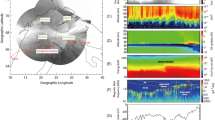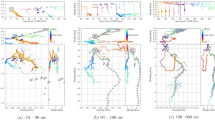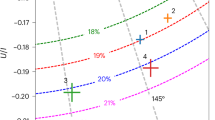Abstract
SINCE January 1977 a new radar auroral backscatter facility, STARE—Scandinavian Twin Auroral Radar Experiment—has been in operation in northern Scandinavia. It consists of two multibeam radars that are sensitive to electrostatic ion waves (irregularities) produced in association with current in the auroral zone E region. The radars measure the intensity and Doppler velocity of irregularities within a 200,000 km2 common area. The measurements are made with an effective spatial resolution of approximately 20×20 km2 and a temporal resolution of 20 s. From the Doppler velocity data it is possible to determine the mean irregularity drift velocity field within the common area. It has been shown1 that this mean velocity is approximately equal to the electron drift velocity which, in the E region, is given by E×B /B2. Because of the spatial and temporal resolution of the STARE system, it is well suited for the study of ionospheric electric fields associated with PC5 geomagnetic pulsations (period 150–600 s). Here we present the first results of the analysis of such an event which occurred between 1230 and 1300 UT (∼1500–1530 MLT) on 2 February 1977. This event is typical of one class of PC5 events that we are studying. The magnetic data used in the study come from one of a chain of high precision rubidium vapour magnetometers designed for geomagnetic pulsation research. These have been operated in Scandinavia since October 1976 by the Institute of Geological Sciences as part of its participation in the IMS. These instruments have an essentially flat frequency response and a noise level typically⩽0.1 nT. The magnetic variations in three orthogonal directions (magnetic NE, NW, and Z) are sampled at 2.5-s intervals with a daytime resolution of 0.08 nT and digitally recorded on magnetic tape cassettes.
This is a preview of subscription content, access via your institution
Access options
Subscribe to this journal
Receive 51 print issues and online access
$199.00 per year
only $3.90 per issue
Buy this article
- Purchase on Springer Link
- Instant access to full article PDF
Prices may be subject to local taxes which are calculated during checkout
Similar content being viewed by others
References
Ecklund, W. L., Balsley, B. B. & Carter, D. A. J. geophys. Res. 82, 195–197 (1977).
Greenwald, R. A., Weiss, W., Nielsen, E. & Thomson, N. R. Radio Sci. (in the press).
Kaneda, E., Kokubun, S., Oguti, T. & Nagata, T. Rep. Ionosph. Space Res. Japan, 18, 165–172 (1964).
McDiarmid, D. R. & McNamara, A. G. Ann. Geophys. 28, 433–441 (1972).
Nishida, A. J. geophys. Res. 69, 1861–1874 (1964).
Inoue, Y. J. geophys. Res. 78, 2959–2976 (1973).
Hughes, W. J. Planet. Space Sci. 22, 1157–1172 (1974).
Southwood, D. J. Planet. Space Sci. 22, 483–491 (1974).
Chen, L. & Hasegawa, A. J. geophys. Res. 79, 1024–1032 (1974).
Hughes, W. J. & Southwood, D. J. J. geophys. Res. 81, 3241–3247 (1976).
Author information
Authors and Affiliations
Rights and permissions
About this article
Cite this article
WALKER, A., GREENWALD, R., STUART, W. et al. Resonance region of a PC5 micropulsation examined by a dual auroral radar system. Nature 273, 646–649 (1978). https://doi.org/10.1038/273646a0
Received:
Accepted:
Issue Date:
DOI: https://doi.org/10.1038/273646a0
This article is cited by
-
Radar studies of magnetosphere dynamics
Astrophysics and Space Science (1995)
-
Low-frequency fluctuations of the electric field in the equatorial ionosphere
Nature (1985)
-
Geomagnetic field: New view on oscillations of magnetic shells
Nature (1983)
-
Micropulsations observed by whistler-mode transmissions
Nature (1978)
Comments
By submitting a comment you agree to abide by our Terms and Community Guidelines. If you find something abusive or that does not comply with our terms or guidelines please flag it as inappropriate.



